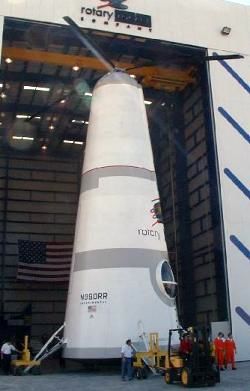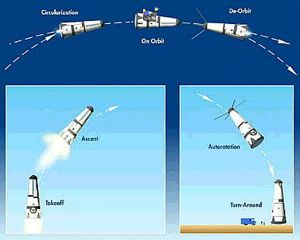
Home - Search - Browse - Alphabetic Index: 0- 1- 2- 3- 4- 5- 6- 7- 8- 9
A- B- C- D- E- F- G- H- I- J- K- L- M- N- O- P- Q- R- S- T- U- V- W- X- Y- Z
Roton
 Roton |
Status: Cancelled 2000. Payload: 3,200 kg (7,000 lb). Gross mass: 180,000 kg (390,000 lb). Height: 19.50 m (63.90 ft). Diameter: 6.70 m (21.90 ft). Apogee: 300 km (180 mi).
The Roton was a fully reusable, single-stage-to-orbit (SSTO) Vertical Take-off and Landing (VTOL) space vehicle designed to transport up to 3200 kg to and from a 300 km / 50 degree inclination earth orbit.
The Roton was planned in 1998 to reach commercial service in the year 2000 with a target price per flight of $7 million. The cargo envelope for the vehicle was 3.66 m in diameter and 5.08 m in height.
The original Roton design was to use an innovative novel rotary engine harking back to the Aerojet Rotojet design of World War II. Later this was changed to a version of NASA's Fastrac Engine using Kerosene and Liquid Oxygen propellants. Several would be required to provide the necessary thrust at take-off. Roton would have a height of 19.5 m, a diameter of 6.7 m and a maximum gross lift-off weigh of under 180 metric tons. Using the Fastrac engines, Roton would have to have an empty weight under 5 % of its gross takeoff mass - a very challenging figure for an expendable rocket, let alone the additional mass of the crew, rotor system, and thermal protection system.
The Roton would takeoff vertically like a conventional rocket powered by a novel rotary engine burning liquid oxygen and jet fuel. The launch system infrastructure for the Roton was expected to be minimal with only a towing truck, standard refueling equipment and support lines, a blast pad, and a small launch platform. The Roton would lift-off under command of the crew and would fly to orbit from the Mojave, California launch site, using standard GPS and inertial navigation flight control systems. The launch path of the vehicle would be very steep, traveling only 28 km downrange at an altitude of 30 km. Following the main engine cut-off at about 130 km, the Roton would circularize its orbit using its orbital maneuvering engines. In orbit the vehicle had a maximum stay time of 72 hours.
Once its payload was deployed, the Roton returned to Earth via a nose-mounted rotor. The rotor recovery system was lightweight and provided a slow, pilot-controlled approach to the landing site. The rotor system consisted of a set of four rotor blades, a rotor hub and nose cap. During launch, the blades were folded down along the sides of the vehicle and before re-entry they were deployed and angled upward away from the nose. During the hypersonic and supersonic phases of flight, the base of the vehicle produced most of the drag while the rotor remained windmilling behind the vehicle, stabilizing it until it reached subsonic speed. Use of water in an active-cooling system was considered. The rotor would then be spun up and the blades entered a helicopter-style autorotation flight mode. While in this mode the Roton was able to glide with the pilot's direction to a precision landing point. The vehicle's rotors would be equipped with tip rockets so that the Roton could touchdown softly under rotor power. After landing the vehicle would undergo minor maintenance and checkout procedures to prepare it for its next flight. In order to meet the target operational cost goals of this project, the Roton was being designed to operate much like a commercial aircraft.
From the outset, the Roton was also designed to return from space with a fully loaded payload bay. Therefore if a spacecraft was damaged or malfunctioned prior to deployment, it could be returned for repair. Rotary Rocket expected a market to develop whereby satellite operators, manufacturers, and insurance companies send rescue missions to repair or retrieve damaged or outdated satellites. In addition to this service, the Roton's low cost of operation and payload-return capability would also allow for the development of an orbital materials processing industry. The vacuum and zero-g environment of space provided ideal conditions to manufacture a variety of materials as well as conduct research.
The Roton large-scale Air Test Vehicle began flight tests in 1999 to demonstrate the autorotation and rotor capabilities. Thereafter technical challenges and lack of sufficient investment stalled the project, then finally killed it.
Crew Size: 2. LEO Payload: 3,200 kg (7,000 lb) to a 300 km orbit at 50.00 degrees. Launch Price $: 7.000 million in 1999 dollars.
Family: Manned spacecraft, orbital launch vehicle, SSTO, US Rocketplanes. Country: USA. Spacecraft: Roton.
 | Roton profile Roton flight sequence |
1999 - . Launch Vehicle: Roton.
- The Roton large-scale Air Test Vehicle began flight tests - . Nation: USA. The Roton large-scale Air Test Vehicle began flight tests to demonstrate the autorotation and rotor capabilities. Thereafter technical challenges and lack of sufficient investment seemed to stall the project and then kill the project..
Back to top of page
Home - Search - Browse - Alphabetic Index: 0- 1- 2- 3- 4- 5- 6- 7- 8- 9
A- B- C- D- E- F- G- H- I- J- K- L- M- N- O- P- Q- R- S- T- U- V- W- X- Y- Z
© 1997-2019 Mark Wade - Contact
© / Conditions for Use